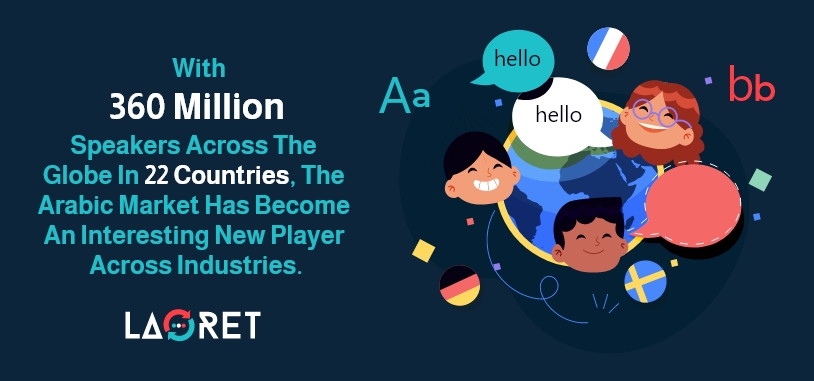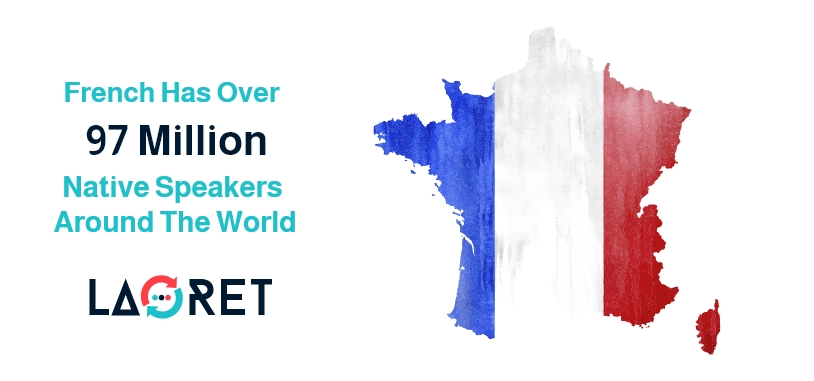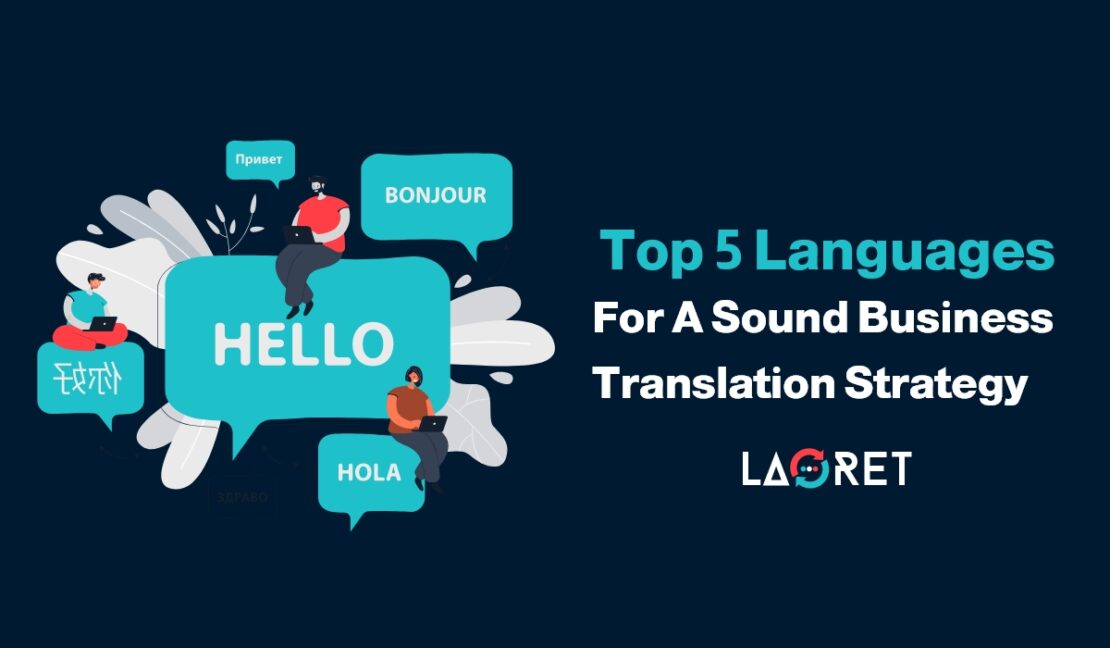Top 5 Languages For A Sound Business Translation Strategy
Is your business ready to leave its mark on the world?
Then you may have wondered how to actually get started. You know you will need to enter new markets with a full strategy, which ensures you translate your business content – among many other things. But where should you get started?
Effective business translation begins with that one question: which markets should I target?
We have the answer for you! Have a look at our top 5 languages for business translation, why they will make a difference for your business, and what to watch out for!
This Is What Successful Business Translation Looks Like
First things first! Let’s have a look at what business translation services are really about.
Business translation includes the linguistic, technical, and cultural adaptation of any content that either promotes your business, helps you form international partnerships, or indeed supports maintaining a multicultural or international business presence.
What Business Translation Should Include?
- Website Translation
- Business Document Translation such as legal documents or HR forms
- Business Interpreting to optimally support your collaborations and partnerships when expanding into new markets
- Translating internal corporate communications such as newsletters, onboarding, and job descriptions.
- Marketing Translation such as campaigns, email marketing, and social media
Delivering Business Translation That Does The Job
Any content that represents you as a brand will have to meet certain standards to ensure your target locale can engage with you in a positive way. Your business translation should
- Be Accurate
- Speak to the target local’s cultural framework.
- Comply with local regulations
- Be fully secure
To meet these standards, we recommend the following.
- Human Translation.
More specifically, translations should be performed by native, in-country linguists who are specialized in your field. This means that the linguistic integrity of your content is safeguarded, but also that any references that are considered ineffective or in bad taste, are avoided. They should also have knowledge of the legal requirements that local and global regulatory bodies put in place.
- Machine Translation (MT).
While we do advise human translation for any marketing-related projects or content that needs to move and connect, some content types can benefit from MT. Not that we recommend it, but if you have to, use it cautiously. Learn about this in our blog How Is Machine Translation Post-Editing (MTPE) Best Executed?
- Top-of-the-line Translation CAT Tools.
To implement effective terminology management, tools such as Translation Memory (TM), a glossary, and a style guide can be leveraged. The TM will save any previously translated terms, the glossary contains a list of company-related terms and phrases, and the style guide lists stylistic and preferential items.
- A Language Service Provider
We recommend that you connect with a professional language services provider or a translation agency to take advantage of their typically expert teams, technology, and robust QA processes.
This includes a proven Translation, Editing, and Proofreading process to weed out any inaccuracies, a final QA check that includes linguistic, functional, and cosmetic testing, and ISO certifications that guarantee industry standards are met.
- Confidentiality Agreements.
To ensure full security of possible sensitive documents, you should only share your files and requests with companies that use end-to-end encryption in all of their communications and are open to signing a Non Disclosure Agreement.
Top 5 Languages To Launch Your Business Translation Strategies
1. Chinese: Impressive Market Potential
Let’s get started with some numbers!
When developing a business translation strategy, Chinese should be at the top of your list. With over one billion native speakers, Chinese is the most widely spoken language in the world.1 China is an economic powerhouse that is overtaken only by the United States,2 and the Chinese language has experienced growth in its online presence of 2,650 percent between 2000 and 2021. What’s more, China accounts for 19.4% of the world’s internet users.3
With an increase in online presence, China has been entering the global business stage in various industries, with eCommerce being one of their largest sources of income. Annual online sales hit a whopping $2.8 trillion in 2022 with a total share of retail sales of 52%, making China the eCommerce world leader.4
Now, you may think that these numbers alone are enough reason to make Chinese part of your business translation plans. But here is the clincher. Of the country’s 1.4 billion inhabitants, only 1% speak English.5 And despite the impressive growth of online users, only 1.4% of online content is translated into Chinese.6
-
Which Way To Go? Mandarin? Cantonese? Simplified Chinese? Or Traditional Chinese?
We have already stressed the importance of native linguists, but in this section, we will drive it home once more. When it comes to the written language, Chinese has two main versions: traditional and simplified Chinese. Simplified Chinese was introduced by the communists in the 1950s in a bid to boost literacy among the Chinese population.7 And while it is still a dominant writing system today, the traditional version is still used in Hong Kong, Macau, and Taiwan. To make it even more complicated, there is a traditional Chinese version for Hong Kong, and one for Taiwan. In terms of spoken languages, Mandarin Chinese is the most commonly used, but Cantonese and other minority languages including Shanghainese, Taiwanese, and Hunanese, are still spoken across the nation.8Long story short, it will take a team of native experts to identify the ideal language form or dialects that you should use to target your audience in the most effective way possible.
2. Spanish: Spanish Business Translation Opens Doors
As the world’s most spoken language after Mandarin, Spanish definitely made our list. With close to 500 million native speakers worldwide in Europe, Latin America, and the United States, Spanish business translation can be a treasure trove on a global scale.9 But beyond this, Spanish also boasts a fast-growing online usage. Spanish-speaking users have increased by 1,511 percent between 2000 and 2021.10
While Spanish translation will help you break into the Latin American and Spanish markets, you may also gain a loyal following in the United States, where 13% of the population speaks Spanish, making it the second largest population of Spanish speakers after Mexico.11
-
Be Aware of Specific Countries and Regions
You may have guessed that with expansion in Europe, Latin America, and the US, the Spanish language comes in many different variants. And you’d be right. Depending on which country or even region you will be translating for, there will be vital differences in the language. And selecting the right vocabulary and tone for each and every single community will not only show respect, but also show your potential new audiences that you are a business they can take seriously. Seriously™ is the operating word here, because some businesses have made a fool of themselves when trying to cheap out on Spanish translations and using one translation for all markets.
This can be especially tricky when translating for marketing campaigns that require a fair bit of creative language use which only qualified natives can provide. For example, Parker Pens made a pretty laughable blunder when their campaign that explains how their pens would not leak in your pockets or make them pregnant.12
3. Arabic: A Language with Unprecedented Growth?
With 360 million speakers across the globe in 22 countries,13 the Arabic market has become an interesting new player across industries. While the Arab economy is still flourishing due to the oil industry,14 knowledge and innovation is feeding more sustainable and varied economic growth.15
Beyond impressive economic strides, Arabic is also making a big splash in the online world. 69% of the population is active on the internet, which is almost double compared to 2014.16
-
The Nuances of the Arabic Language
However interesting and important Arabic may be, translating into this language is not that simple as there are linguistic, cultural, and technical challenges. Arabic comes in different dialects, and not all of them are mutually intelligible. Arabic does have a standardized written form called Modern Standard Arabic (MSA) that developed in the 19th and 20th centuries. Because of its generalized and formula nature, MSA is well-suited for informational content or even specific media types such as newspapers.
However, this will not be the case when you are developing marketing content or any other type of content where emotional connections and driving an audience to action are central. Here, colloquial Arabic is preferred.
Beyond this, Arabic is a right-to-left (RTL) language, meaning that layouts and user interfaces will need to be adjusted accordingly to fit the new design. For this, Desktop Publishing experts should be involved to make sure that the content and the visual features all align perfectly and mirror the source material.

4. French: A Post-Brexit Growth Spurt and Contribution to Global Inclusion
- French is more than just the language of love! French has over 97 million native speakers around the world,17 and it is actually a really exciting language for anyone looking to expand their business in Europe and beyond. Post-Brexit, French is projected to play a more vital role within Europe as English is slowly but surely disappearing from some of the official EU communications.18 What’s more, since technology and internet usage are on the rise in Africa, which is largely French-speaking, a whole new French-speaking market is ready to be leveraged.19
-
Europe? Canada? It Matters.
While French may be more quickly linked with Europe and even Africa, it is a national language in Canada as well. And much like other languages with such a wide distribution, skilled linguists will need to be engaged in order to navigate the language variations effectively.
For example, in Canada, French is very influenced by the country’s other national language, English. This means that Anglicanisms tend to creep in, while European French is almost entirely void of that. Additionally, Canadian French is often perceived as archaic by European French speakers, since the Canadian communities did not have the exposure to different languages and cultures to the extent that Europe did.
These may sound like minor issues as they are mutually intelligible. That being said, a potential new client will need more than to simply recognize what is said. In order to have the full effect, content will need to strike home and connect at a deeper, cultural level.
-

5. German: A Big Player in The Science, Engineering, And the Automotive Industry
German has around 130 million native speakers distributed over 45 countries and is taking a more central role in European communications after Brexit next to the above-mentioned French.
But more than just a budding language for EU diplomacy, Germany is a central player in the technological and scientific market, making the nation a world leader in machinery, mechanical engineering, and the automotive industry.20
Next to that, Germany’s online community is a very active one as the internet penetration is no less than 89% and is expected to grow to 93% over the next 5 years.21
Get That Business Translation Up to Scientific Perfection!
As we explained before, business translations, especially those with technical content, need to be highly accurate in order to get the results they need in terms of comprehension and safety. With the added challenge of a highly diverse language spoken natively in Germany, Switzerland, Luxembourg, Lichtenstein, Austria, and Belgium, in Europe alone, you have your job cut out for you. This means that your linguists will not only need to be native but also highly specialized in your industry. Additionally, German has an additional translation challenge of a technical nature, in that it is a pretty verbose language. German can take up to 35% more space than English because of its excessive use of compound nouns. Both the expertise of a trained linguist who can make intuitive decisions and a CAT Tool that can set character limits are vital to prevent any issues rated to text expansion.
Conclusion
Business Translation involves adapting all content that represents your brand to your new audiences. And while there are a host of impressive languages to choose from, these 5 will get you started on a path that will help you leave your mark—at least when you accept the help of professional translators who know exactly how to help you make an impact! At Laoret, we provide professional translation services in over 120 languages, all provided by native linguists that know your industry. Get in touch and request a quick quote!
References
- Statista: The world’s most spoken languages
- World Data: The world’s largest economies
- Internet world users by language
- The 10 Largest E-Commerce Markets in the World by Country
- English levels in China
- The most used languages on the internet
- China: Language simplification to increase literacy?
- The main differences between Mandarin and Cantonese
- The Spanish language in the world
- Internet world users by language
- The U.S. Has the Second-Largest Population of Spanish Speakers”How To Equip Your Brand To Serve Them
- Parker pens make you pregnant, and other due diligence fails!
- Arabic Speaking Countries
- Arab economies to post 5.4 percent growth rate this year on higher oil prices
- More Arab countries are seeking to orient their economies towards knowledge
- Individuals using the Internet (% of population) – Arab World
- French speaking countries
- English Loses Currency as Europe’s Lingua Franca After Brexit Vote
- The rise of Africa’s digital economy
- Mechanical Engineering Industry in Germany: Our Industry Report
- Internet user penetration in Germany from 2018 to 2027






